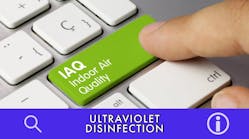DOE workshop brings academic focus to emerging commercial opportunities
The 2021 virtual Lighting R&D Workshop, organized by the US Department of Energy (DOE) and co-sponsored by the Illuminating Engineering Society (IES), brought together lighting industry stakeholders from manufacturers to researchers to government program managers and more to discuss the state of research & development (R&D) that will direct government funding resources and commercial opportunities driven by solid-state lighting (SSL) technologies.
Held over Feb. 1‒4, the workshop centered on the ability to quantify and evaluate intrinsic results and characterize the qualities of light that are desired, both in the built environment and outdoors. Whether the topic was how to exploit observations about the way light behaves in the natural environment to inform new design targets, or what measurable qualities can be utilized to pursue the “ideal light” across various applications, the presentations consistently came back to the central idea of metrics — defining them, using them, verification of results in installation, and continually refining the resulting standards and concepts for practical applications.
DOE kicks off with SSL status update
In his introduction, Lighting R&D Program manager Brian Walker noted that the 2021 event was planned with the question “How can we ‘meet the moment?’” in mind, concluding that “part of the answer is continuity” in delivering a platform for research to be shared.
Next, Building Technologies Office director David Nemtzow summarized the past, present, and future of Lighting R&D activities under the DOE. He cited 335 Lighting R&D projects over the lifetime of the agency’s Solid-State Lighting (SSL) Program, with 431 submitted patents and 346 products directly resulting from related commercial developments, which extend from applied materials to manufacturing tools to devices, components, and end SSL products. Projects have been funded through the Lighting R&D and Small Business Innovation Research (SBIR) Programs.
In reminding attendees about the mission of the program — “We’re here to save energy and improve lighting” — Nemtzow said, “We are saving per annum 140 billion kilowatt-hours” of energy attributable to LED adoption in the US. However, he said that both luminous efficacy and power conversion efficacy still have a ways to go in meeting ultimate DOE goals.
Keynotes lean on innovation
Leading off the keynote, former Cree executive turned independent consultant Chuck Swoboda offered guidance on approaching innovation in ways that resolve problems while creating new business opportunities. Pragmatically, he opined that tangible savings and addressing issues the customer cares about will yield disruptive innovation — not simply inventing for the sake of it. He explained that upon first moving into the LED lamp market, Cree experienced early resistance from retailers and customers, until the value proposition became how much money they would save on energy rather than the long life and reduced maintenance afforded by the LED lamp. He also stated that with regard to the emergence of human-centric lighting, no company has yet framed the value in a similar way that will entice customers — with technology that is easier to use and less expensive to install than what is currently being offered. Swoboda concluded that this builds opportunities for smaller companies to become leaders in the lighting industry, because “large companies have a lot to lose by disrupting their industry.”
Moving on, building engineering and lighting design consultant Star Davis provided a vastly different case for challenging traditional lighting and building design targets in order to accommodate human health and wellbeing. She asked why modern society exhibits an innate desire to escape from the built environment into the natural landscape to recharge, then documented many observations and measurable qualities of light in the natural world that support the need for “restorative and beautiful” environments. Davis has closely studied illuminance and luminance, stating that all designs should start with luminance since it involves the perception of light in the environment (although illuminance has traditionally been easier to measure). She used examples of HDR photography to show the pixel by pixel difference in contrast and light, verified with photometry, in outdoor environments that can be used as the basis for designing welcoming, visually comfortable, and functional environments that leverage SSL technologies to balance energy consumption and human experience.
Related article: A building well lit and well controlled is WELL certified
Illuminating ideals
The first presentation session asked, “What Is Ideal Light?” Jennifer Scheib, University of Colorado Boulder; Ron Gibbons, Virginia Tech Transportation Institute; Tero Mäkinen, LEDiL Optics Oy; and Ian Ashdown, SunTracker Technologies, contributed many different viewpoints on the concept.
Scheib focused on the commercial office environment, stating design goals must be shifted to fulfill health and wellbeing objectives for tasks and comfort, while mitigating climate change, moving to zero energy, and providing resilient infrastructure for all buildings to operate sustainably.
As a transportation lighting specialist, Gibbons summarized studies that examined the potential impact of outdoor lighting on human biology, in addition to the usual concerns of driver and pedestrian safety. While such biological studies are ongoing, said Gibbons, current findings are showing that roadway light levels are mainly below thresholds for impact on melatonin levels. He pointed to adaptive lighting as a way to supply ideal light levels, light distribution, and spectrum to address the needs of varying outdoor conditions, terrain, visual acuity for safety, and respect for sensitive ecosystems. Automation and controls will play a critical part in the outcomes for adaptive roadway systems, he concluded.
Optics specialist Mäkinen commented that “ideal light requirements are pretty ambiguous,” citing varying functional and safety requirements, market expectations, and trends that influence the definition of ideal light depending on the application. He approached the concept of ideal light as one of engineering the beam distribution, achieving uniformity of light output and controlled color over angle. The many options in optical components can optimize the quality of light needed in any situation, indoors or outdoors, said Mäkinen, and even when developing products for germicidal ultraviolet (UV) applications, as the UV radiation must be provided effectively to deactivate pathogens properly.
Ashdown concluded the session talks by tackling design software and visualization tools that can assist in achieving ideal lighting. He said that the current tools need to move away from strictly rendering a space and become capable of utilizing information from “virtual sensors” that will analyze data inputs and simulate outcomes that can represent the human visual perception of lighting, quantify circadian lighting characteristics, verify germicidal actions for UV-C irradiance and fluence rate, and identify plant responses to light in horticultural applications. Ashdown explained that lighting and building design software that leverages these techniques has been developed but remains experimental only, as commercial availability will rely on demand. Indeed, on day 4 of the workshop, several speakers focused on applying data to problems in building and lighting design and advocated for improved uptake of software and automation tools by all aspects of the lighting supply chain, as outlined in our recent blog.
—
This is by no means a full synopsis of the DOE workshop program but only a summary of topics this writer found compelling. Look for an upcoming report on additional workshop topics in wellbeing and circadian lighting, UV, and the LED supply chain. On-demand presentations can be accessed from the Lighting R&D Workshop event page if you are already a registered attendee.
For up-to-the-minute LED and SSL updates, why not follow us on Twitter? You’ll find curated content and commentary, as well as information on industry events, webcasts, and surveys on our LinkedIn Company Page and our Facebook page.

Carrie Meadows | Editor-in-Chief, LEDs Magazine
Carrie Meadows has more than 20 years of experience in the publishing and media industry. She worked with the PennWell Technology Group for more than 17 years, having been part of the editorial staff at Solid State Technology, Microlithography World, Lightwave, Portable Design, CleanRooms, Laser Focus World, and Vision Systems Design before the group was acquired by current parent company Endeavor Business Media.
Meadows has received finalist recognition for LEDs Magazine in the FOLIO Eddie Awards, and has volunteered as a judge on several B2B editorial awards committees. She received a BA in English literature from Saint Anselm College, and earned thesis honors in the college's Geisel Library. Without the patience to sit down and write a book of her own, she has gladly undertaken the role of editor for the writings of friends and family.
Meadows enjoys living in the beautiful but sometimes unpredictable four seasons of the New England region, volunteering with an animal shelter, reading (of course), and walking with friends and extended "dog family" in her spare time.





![The DesignLights Consortium continues to make progress in shifting outdoor lighting products and implementation practices toward a more restrained and thoughtful strategy. [Image does not represent a DLC qualified fixture.] The DesignLights Consortium continues to make progress in shifting outdoor lighting products and implementation practices toward a more restrained and thoughtful strategy. [Image does not represent a DLC qualified fixture.]](https://img.ledsmagazine.com/files/base/ebm/leds/image/2024/08/66be810888ae93f656446f61-dreamstime_m_265700653.png?auto=format,compress&fit=&q=45&h=139&height=139&w=250&width=250)
